NavSource Online: Submarine Photo Archive
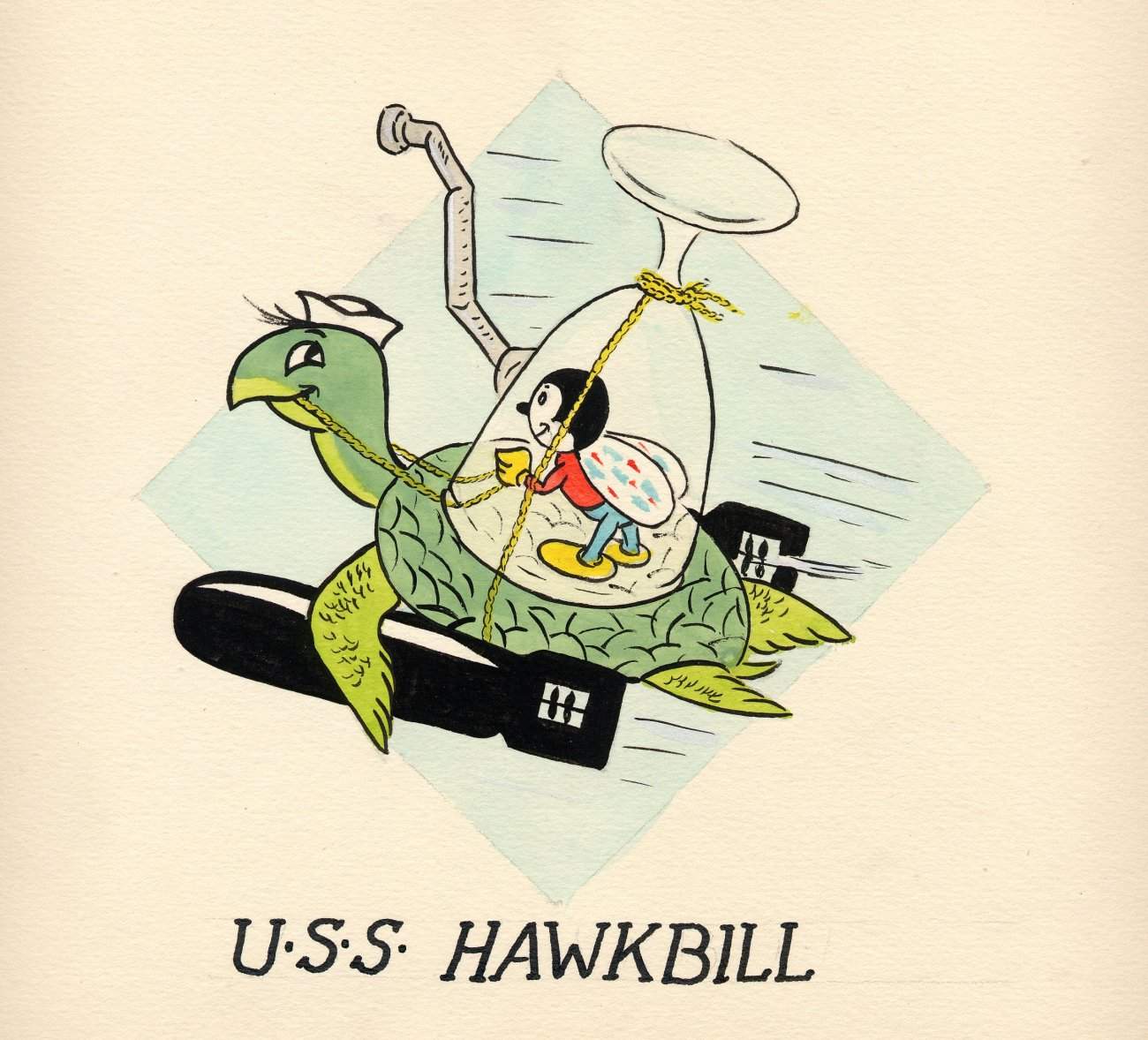
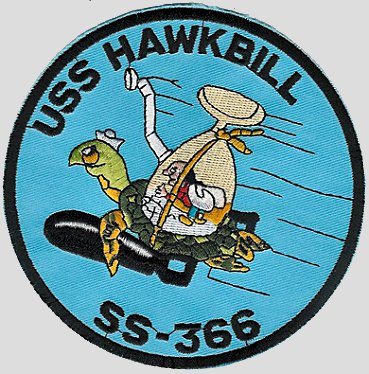
Patch on left contributed by Harold F.(Carl) Carlson & submitted by Gary Carlson, on right by Don McGrogan, BMCS, USN (ret.)
Please report any broken links or trouble you might come across to the Webmaster.
Please take a moment to let us know so that we can correct any problems and make your visit as enjoyable and as informative as possible.


| Click On Image For Full Size | Size | Image Description | Source | |
|---|---|---|---|---|
 | 15k | Commemorative postal cover on the occasion of the Hawkbill's (SS-366) keel laying, 7 August 1943. | Courtesy of Jack Treutle (of blessed memory). | |
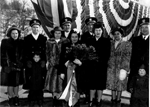 0836613 |
502k | Christening party of the submarine Hawkbill (SS-366) at Manitowoc Shipbuilding Company. Commander Francis W. Scanland, Jr. and his wife, the sponsor of the submarine, at center, Exec. G.W. Grider on right, 9 January 1944. | This photo # P70-7-402, can be ordered (without the watermark) from the Wisconsin Maritime Museum. | |
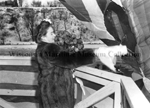 0836620 |
493k | Mrs. Francis W. Scanland, Jr., sponsor of the Hawkbill (SS-366), breaking the christening bottle over the bow of the submarine at Manitowoc Shipbuilding Company on 9 January 1944. | This photo # P70-7-406, can be ordered (without the watermark) from the Wisconsin Maritime Museum. | |
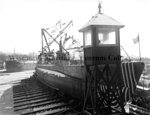 0836618 |
428k | Starboard bow view of the Manitowoc built submarine Hawkbill (SS-366) on the ways at Manitowoc Shipbuilding Company on 9 January 1944. | This photo # P70-7-404, can be ordered (without the watermark) from the Wisconsin Maritime Museum. | |
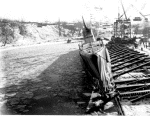 | 61k | Hawkbill (SS-366), being side launched at Manitowoc Shipbuilding Co., Manitowoc, WI., 9 January 1944. | Editors Note: There are over 200 images submitted on these pages covering the following submarines that were constructed at the Manitowoc Shipbuilding Co, Manitowoc, WI,: SS-265 through SS-274, and SS-361 through SS-380. None of them would have seen the light of day if it were not for the efforts of Curator, Asst. Director, Bill Thiesen of the Wisconsin Maritime Museum and Larry Bohn, who sent them to NavSource for publication. A special debt of gratitude is owed to these two men and the Wisconsin Maritime Museum, home of the Cobia (SS-245), for allowing these photographs to be seen by the lovers of naval history worldwide. | |
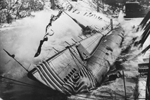 | 218k | Hawkbill (SS-366), splashes into the waters of the Manitowoc River at Manitowoc Shipbuilding Co., Manitowoc, WI., 9 January 1944. | USN photo courtesy of ussubvetsofwwii.org. | |
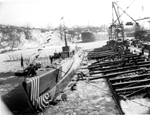 0836616 |
499k | Port bow view of the Manitowoc built submarine Hawkbill (SS-366) immediately after launch at Manitowoc Shipbuilding Company on 9 January 1944. | This photo # P70-7-407, can be ordered (without the watermark) from the Wisconsin Maritime Museum. | |
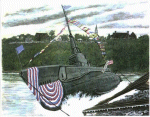 | 55k | Watercolor print by the artist Tom Denton of the side launching of a Manitowoc built boat. | Courtesy of submarineart.com | |
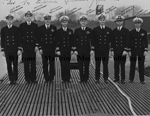 0836614 |
590k | Officers of the Manitowoc submarine Hawkbill (SS-366) standing on deck. Signed To Bernie Glaeser from the Hawkbill, 1944. Names written written above heads: Asst. Engr E.A. Schroeder; Com'C'tns G.H. Christopher; Commisary Rex L. Murphy; Comm. F.W. Scanland; Exec. G.W. Grider; Engineer F.B. Tucker; Asst. Gunn'r L.R. Fokele; Gunn. R.J. Jackson. | This photo # P98-6-1, can be ordered (without the watermark) from the Wisconsin Maritime Museum. | |
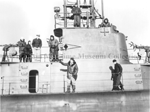 0836617 |
443k | Close-up view of the crew of the Manitowoc-built submarine Hawkbill (SS-366) standing around the conning tower in January 1944. | This photo # P68-1-87, can be ordered (without the watermark) from the Wisconsin Maritime Museum. | |
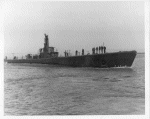 | 92k | Hawkbill (SS-366), underway during her sea trials shortly after being launched in the Manitowoc Harbor, 9 January 1944. | Courtesy of John Hummel, USN (Retired). | |
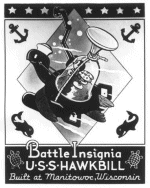 | 37k | Battle insignia of the Hawkbill (SS-366). | Photo by Harry Berns, Official photographer of the Manitowoc Shipbuilding Co., Manitowoc, WI. Submitted by Larry Bohn, courtesy of the Wisconsin Maritime Museum, home of the Cobia (SS-245) | |
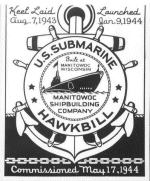 | 44k | Commissioning emblem of the Hawkbill (SS-366). | Photo by Harry Berns, Official photographer of the Manitowoc Shipbuilding Co., Manitowoc, WI. Submitted by Larry Bohn, courtesy of the Wisconsin Maritime Museum, home of the Cobia (SS-245) | |
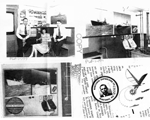 | 485k | Photo of Harry Berns, Official photographer of the Manitowoc Shipbuilding Co., Manitowoc, WI. The photo of the Golet (SS-361) encased in snow appears on the wall above him on the upper right. His obituary appears here. | Photo courtesy of Susan Menk, Archives Assistant, Wisconsin Maritime Museum, Dee Anna Grimsrud,Reference Archivist, Wisconsin Historical Society, Steve Khail, CBC, Director of Investor Relations & Corporate Communications, The Manitowoc Company, Inc. & William Young. | |
 | 11k | Commemorative postal cover on the occasion of the commissioning of the Hawkbill (SS-366), 17 May 1944. | Courtesy of Jack Treutle (of blessed memory). | |
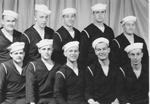 0836627 |
921k | Mike Struz, front row 2nd from left, along with other Hawkbill (SS-366) crewmembers. | Photo via Earl Bjorndal. | |
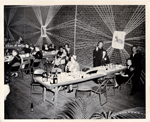 0836624 |
1.80k | Commissioning party of the Manitowoc built submarine Hawkbill (SS-366), 17 May 1944. | Photo courtesy of plank member Mike Struz via Earl Bjorndal. | |
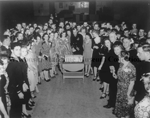 0836619 |
506k | Crew and guests standing around the cake at the commissioning party for the Manitowoc built submarine Hawkbill (SS-366), 17 May 1944. | This photo # P96-15-10, can be ordered (without the watermark) from the Wisconsin Maritime Museum. | |
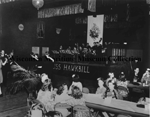 0836615 |
474k | View of the dance hall, girls seated at tables in foreground, and the band on stage at the commissioning party of the Manitowoc built submarine Hawkbill (SS-366), 17 May 1944. | This photo # P96-15-13, can be ordered (without the watermark) from the Wisconsin Maritime Museum. | |
 | 88k | Hawkbill (SS-366), armed with one 5" gun, (127mm), one 40mm anti-aircraft gun on the forward bridge sponson and one 20mm on the after sponson. She wears the light gray finish adopted in 1943. She is possibly sailing down the Mississippi River on her way to the war in the Pacific, circa Spring 1944. | Courtesy of Erminio Bagnasco book, "Submarines of WW II", submitted by Aryeh Wetherhorn. | |
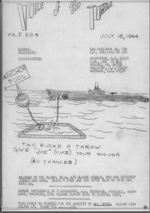 0836621 |
944k | 14 page PDF edition of 18 July 1944, Voice of the Turtle, newspaper of the Hawkbill (SS-366). | PDF crerated by Earl Bjorndal. | |
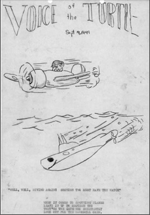 0836622 |
407k | 4 page PDF edition of 19 September 1944, Voice of the Turtle, newspaper of the Hawkbill (SS-366). | PDF crerated by Earl Bjorndal. | |
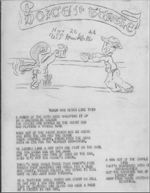 0836623 |
667k | 10 page PDF edition of 26 November 1944, Voice of the Turtle, newspaper of the Hawkbill (SS-366). | PDF crerated by Earl Bjorndal. | |
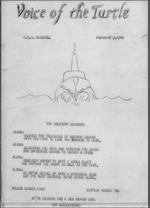 0836626 |
790k | 11 page PDF edition (last page missing) of 9 February 1945, Voice of the Turtle, newspaper of the Hawkbill (SS-366). | PDF crerated by Earl Bjorndal. | |
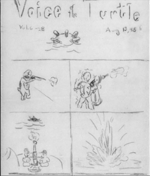 0836628 |
899k | 13 page PDF edition of 13 August 1945, Voice of the Turtle, newspaper of the Hawkbill (SS-366). | PDF crerated by Earl Bjorndal. | |
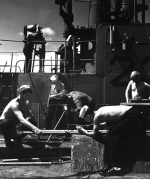 | 440k | Text accompanying this photo reads "Enlisted men repair and check instruments aboard a submarine just returned to Pearl Harbor, Hawaii. May 1945." Note: Many of the captions of Bristol's photography are lacking in details and some have the wrong dates, places and locations. The "23" boat in question in this photo is definitely NOT the S-23 (SS-128). It is beyond a doubt a Salmon or Gato/Balao class fleet boat, and I would lean toward a Balao. The date of the photo is probably early to mid 1944. The boat in question has the characteristicly fat, twin periscope shears and long, wide flat "cigarette" deck of a Balao. Directly above the head of the sailor who is working at the base of the aft scope is a radar mast. The sailor behind him is standing at and looking through the aft Target Bearing Transmitter (TBT). Barely visible on the far left of the photo is what I believe to be part of a 20 mm gun mount. None of these features were ever present on any of the S-boats, even the later 40 series that were heavily modified (i.e. S-45 (SS-156) ) towards the end of the war. The whole conning tower fairwater on the boat in question is simply too large for a S-boat. As for the "23" on the fairwater, I have seen wartime photos of fleet boats displaying mysterious one and two digit numbers that do not correspond to their hull number (see the Guardfish (SS-217) and Peto (SS-265) pages for examples). Despite a lot of research, I have not turned up an official explanation for these strange numbers. One source said that they were squadron or flotilla identifiers, but I can't back this up officially. It is possible that they were temporary numbers assigned while the boats were in home waters, maybe to cut down on friendly fire incidents. Strangely enough, these numbers also seemed to have been used briefly during WWI, as I have seen them on D, E, F, G, and H-class boats. It is also entirely possible that these numbers are part of an official disinformation program designed to obscure the identities of the boats while allowing a wide distribution of photos to an information hungry wartime public. That would also account for the information inaccuracies attributed to otherwise highly thought of photographers. Riveted construction on the conning tower fairwaters of the fleet boats was far more common than I previously thought. It seems that the fairwater plating was riveted to the supporting structure underneath during construction on virtually all of the fleet boats, no matter who built it. This was possible due to the fact that the fairwater was non-watertight and merely provided for a smooth flow of water around the conning tower and lower periscope shears. Riveting was a long practiced and well known construction method, while welding was still relatively new and there was a fairly low number of skilled and experienced welders, and they had to be parceled out carefully depending on priority. All of the pressure resisting elements such as the conning tower and the main pressure hull were welded. The last fleet boat to have a riveted pressure hull was the Pompano (SS-181) in 1937. These original riveted fairwaters were retained until the end of the war, unless the boat had major rework of the fairwater performed (like most of the Gato's), or if the boat suffered battle damage. The rework jobs seemed to have been mostly welded. I would lay money on it being a Manitowoc built Balao class and I will stick with the early to mid 1944 date. |
National Archives Record Administration (NARA) photo # 80-G-468179 & HD-SN-99-02504 by Lt. Comdr. Horace Bristol, from the Department of Defense Still Media Collection, courtesy of dodmedia.osd.mil. Partial text courtesy of Jason McDonald, President & Executive Producer MFA Productions LLC. worldwar2database.com Majority of text and photo i.d. courtesy of David Johnston |
|
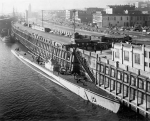 | 75k | Hawkbill (SS-366), on the Willamette River, Portland, Oregon October, 1945 after the end of the Pacific War. | Courtesy of usshawkbill.com | |
 | 137k | Reserve fleet at Mare Island, circa January 1946. There are 52 submarines and 4 Sub Tenders in this photo. This photo is a Berthing list identifying the ships in the picture. | Photo commemorating 50 years, U. S. Submarine Veterans of WW II 1996 calendar, courtesy of Darryl L. Baker. | |
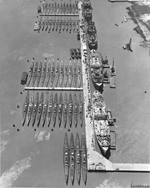 | 453k | Photo of the Reserve fleet at Mare Island, circa January 1946. There are 52 submarines and 4 Sub Tenders in this photo. Whether coincidental or on purpose, the number of boats in the photo is the same as that which were lost in WW II. From back to front and left to right, first group of 12 boats: Sand Lance (SS-381) Tunny (SS-282) Aspro (SS-309) Lionfish (SS-298) Guvania (SS-362) Sunfish (SS-281) Macabi (SS-375) Gurnard (SS-254) Pampanito (SS-383) Mingo (SS-261) Guitarro (SS-363) Bashaw (SS-241) From back to front and left to right, second group of 12 boats: Sealion (SS-315) Hammerhead (SS-364) Bream (SS-243) Seahorse (SS-304) Tinosa (SS-283) Pintado (SS-387) Mapiro (SS-376) Pipefish (SS-388) Moray (SS-300) Batfish (SS-310) Hackleback (SS-295) Bluegill (SS-242) From back to front and left to right, third group of 12 boats: Hawkbill (SS-366) Menhaden (SS-377) Perch (SS-313) Loggerhead (SS-374) Barbero (SS-317) Baya (SS-318) Hardhead (SS-365) Spadefish (SS-411) Springer (SS-414) Devilfish (SS-292) Kraken (SS-370) Dragonet (SS-293) From back to front and left to right, fourth group of 12 boats: Lamprey (SS-372) Piranha (SS-389) Manta (SS-299) Pargo (SS-264) Rancador (SS-301) Archerfish (SS-311) Mero (SS-378) Sawfish (SS-276) Spot (SS-413) Lizardfish (SS-373) Jallao (SS-368) Icefish (SS-367) From back to front and left to right, last group of 4 boats: Steelhead (SS-280) Puffer (SS-268) Stickleback (SS-415) Trepang (SS-412) From back to front, Submarine Tenders group of 4 ships: Pelias (AS-14) Aegir (AS-23) Euryale (AS-22) Griffin (AS-13) | Photo commemorating 50 years, U. S. Submarine Veterans of WW II 1996 calendar, courtesy of Darryl L. Baker. | |
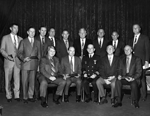 | 1.50k | Crew members of first Hawkbill (SS-366) at the reception following the commissioning of the Hawkbill (SSN-666) at Mare Island: Seated Bill Williams, Douglas Y. Nichols, CDR C. H. Brown (Commanding Officer), Hawkbill, C. F. Franfurt, Kenneth H. Meuser. Rear row: Robert High, Eric Schroder, Gover S. Melson, Bill Munson, Robert Guidi, Rex L. Murphy, Joe Petrosky, Dick Jackson and Joseph A. Kail. | USN photo # 102436-2-71 TH 01, courtesy of the Vallejo Naval and Historical Museum via Darryl L. Baker. | |
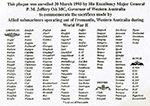 |
365k | This plaque was unveiled 20 March 1995 by His Excellency Major General P.M. Jeffery OA MC, Governor of Western Australia to commemorate the sacrifices made by Allied submarines that operated out of Fremantle, Western Australia during WW II. | Photo courtesy of Ron Reeves (of blessed memory). | |
 Zeeleeuw (S-803) Zeeleeuw (S-803) |
||||
 | 94k | ex-Hawkbill (SS-366), as the Dutch Zeeleeuw (S-803) arriving in (probably) Plymouth, England. Note the geruispeiler (sonar) on the portside forward of the sail. Circa early 1950s. | Courtesy of Ben Uenk / dutchsubmarines.com. | |
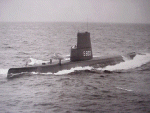 | 53k | ex-Hawkbill (SS-366), as the Dutch Zeeleeuw (S-803) circa 1953. | Courtesy of Nick Kuyper / dutchsubmarines.com. | |
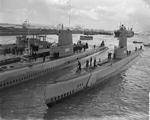 0836712 | 1.03k | ex-Hawkbill (SS-366), as the Dutch Zeeleeuw (S-803) coming alongside ex-Icefish (SS-367), as the Dutch Walrus (S-802), Rotterdam, 7 March 1958. Note unidentified submarines opposite Walrus. | Photographer Herbert Behrens/ Anefo copyright. This is an image from the Nationaal Archief, the Dutch National Archives. Item number: 909-3968, via Robert Hurst. | |
 0836610 | 564k | Dutch naval officers welcoming back the submarine Zeeleeuw (S-803) back from New Guinea, 12 September 1962. | Photographer Harry Pot/ Anefo. This is an image from the Nationaal Archief, the Dutch National Archives. Part number 914-2997 via Robert Hurst. | |
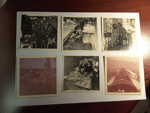 | 967k | Zeeleeuw (S-803) crew life in Norway and France, circa 1968. | Official Royal Netherlands Navy photo courtesy of Peter Jansen. | |
| Back To The Main Photo Index | Back To the Submarine Index |
| Problems and site related matters, E-mail Webmaster |
| This page is created by Gary Priolo, and maintained by Michael Mohl All Pages © 1996 - 2025 NavSource History |